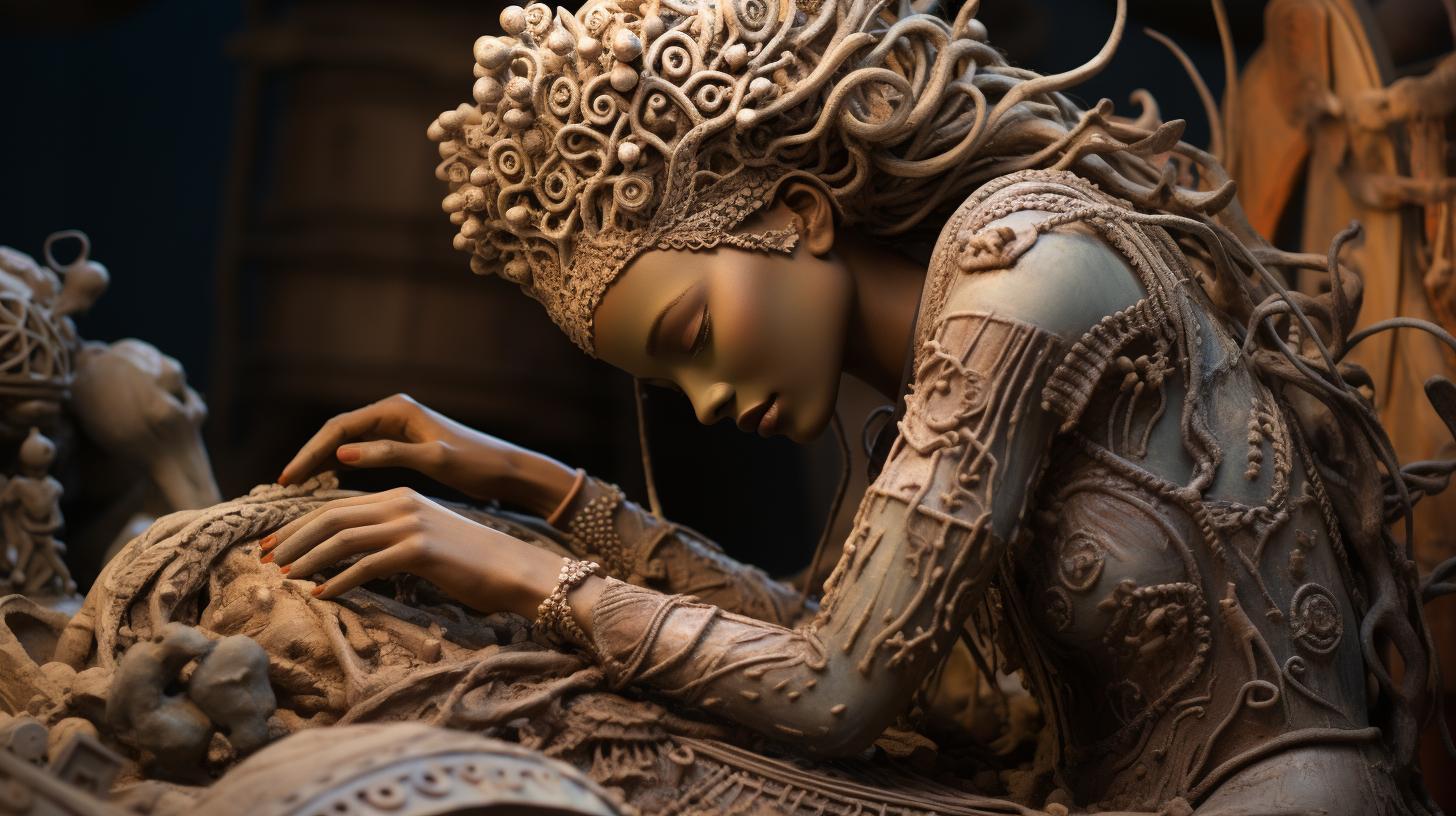Sherida Goddess: Unveiling the Mysteries of the Mesopotamian Dawn Deity

Sherida Goddess holds a significant place in Mesopotamian mythology and worship. As the wife of Šamaš, the sun god, she represents the personification of dawn and morning light.
Her intercessory abilities and involvement in legal matters hold great importance. Temples in Sippar and Larsa were dedicated to her, where she shared worship with her husband. Sherida’s iconography portrayed her beauty and sexual allure.
She is also associated with dreams and connected to other deities such as Sudaĝ, Ninkar, and Shala. This article explores the historical evidence, symbolism, and enduring legacy of Sherida Goddess.
Sherida Goddess in Mythology and Worship
Sherida Goddess holds a significant place in Mesopotamian mythology and religious practices.
Worshiped as the wife of Šamaš (Shamash), the Sun God, she embodies the essence of dawn and morning light, symbolizing the beauty and radiance of a new day.
Sherida as the Wife of Šamaš (Shamash) – The Sun God
Sherida is revered as the devoted spouse of Šamaš, the prominent deity associated with the sun.
Her role as his wife signifies the balance between masculine and feminine energy in the cosmos, while also highlighting the importance of their harmonious union in sustaining life on Earth.
Aya’s Role as the Personification of Dawn and Morning Light
Aya, also known as Sherida, embodies the essence of dawn and morning light.
As the personification of these celestial phenomena, she represents the transition from darkness to light, symbolizing hope, renewal, and the beginning of a new cycle.
Intercessory Abilities and Legal Significance of Sherida Goddess
Sherida is renowned for her intercessory abilities and her crucial role in legal matters.
Considered as a divine mediator, she acts as an intermediary between humans and the divine realm, ensuring justice and fairness. Her presence in legal procedures signifies the belief in divine intervention and guidance.
Sherida’s Worship and Temples: Sippar and Larsa
Worship of Sherida takes place in the prominent temples of Sippar and Larsa. These sacred spaces serve as focal points for devotees to honor and seek the blessings of Sherida and Šamaš.
The shared cult in these temples underscores the inseparable bond between Sherida and her solar consort.
Iconography and Symbolism of Sherida Goddess
The iconography of Sherida Goddess in Mesopotamian art reflects her significance and role in mythology. Depictions of Sherida often portray her in a frontal position, showcasing her beauty and captivating charm.
She is celebrated for her enchanting appeal and sexual allure, symbolizing the power of femininity and fertility.
Depictions of Sherida in Mesopotamian Art
In Mesopotamian art, Sherida is frequently represented with carefully crafted details, emphasizing her captivating attributes. Artists sought to capture her radiance and elegance, often portraying her with flowing garments and intricate adornments.
Their skillful renditions aimed to convey her divine status and celestial connection.
Beauty, Charm, and Sexual Allure of Sherida Goddess
Sherida’s depictions emphasize her extraordinary beauty and alluring charm. Artists used graceful poses, delicate facial features, and dynamic gestures to exude her irresistible appeal. These representations not only celebrate her physical attractiveness but also symbolize her role as the bringer of light and rejuvenation.
Connections to Other Related Deities: Sudaĝ, Ninkar, and Shala
- Sudaĝ: Sherida shares connections with Sudaĝ, another deity associated with dawn and the morning. They represent different aspects of the same celestial phenomenon, collaborating in the cycle of cosmic renewal.
- Ninkar: Ninkar, also linked to Sherida, is a goddess of dreams.
Together, they illustrate the realm of dreams and the importance of their interpretation in ancient Mesopotamian culture.
- Shala: Though less directly connected, Shala, the wife of the weather god Adad, shares Sherida’s association with fertility and agricultural abundance.
Their interconnectedness symbolizes the harmony between the forces of nature and the divine.
Sherida’s Association with Dreams and Symbolic Meanings
Beyond her representation as the personification of dawn and beauty, Sherida is also associated with dreams and their interpretative significance. In Mesopotamian belief, dreams held great importance, and Sherida’s role as a dream deity further highlights her influence in the realm of spirituality and the subconscious mind.
Through her connection to dreams and intertwined symbolism with other deities, Sherida Goddess holds a multifaceted significance that extends beyond her portrayal in Mesopotamian art. Her depictions and associations provide profound insights into the beliefs, values, and spiritual practices of ancient Mesopotamians.
Sherida Goddess: Historical Evidence and Scholarship
The historical evidence and scholarship surrounding Sherida Goddess provide valuable insights into her significance and presence in Mesopotamian mythology. This section explores various aspects related to her historical context, textual references, and scholarly contributions.
Historic Texts and Tablets: References to Sherida in Textual Sources
Through ancient texts and tablets, references to Sherida can be found, shedding light on her worship and role in Mesopotamian society. These sources offer glimpses into the rituals, beliefs, and practices associated with Sherida Goddess.
Contributions of Asher-Greve and Westenholz to Understanding Sherida
Asher-Greve and Westenholz, prominent scholars in the field of Mesopotamian studies, have made significant contributions to our understanding of Sherida Goddess. Their research and interpretations have enhanced our knowledge of her cultural and religious significance.
Analysis of Sherida’s Presence in Ancient Near Eastern Records
By analyzing ancient Near Eastern records, researchers have uncovered evidence that validates the existence and prominence of Sherida in ancient times. These records highlight her role as a revered deity and shed light on the societal and religious context in which she was worshipped.
Impact of Sherida Goddess in the Babylonian and Old Babylonian Periods
Sherida’s influence can be traced through the Babylonian and Old Babylonian periods, where her worship and significance reached its peak. The impact of Sherida Goddess during these periods shaped religious practices, legal procedures, and societal norms.
Understanding the Role of Sherida as a Symbol of Dawn and Rebirth
Since ancient times, Sherida Goddess has held a significant place in Mesopotamian mythology, leaving behind a lasting legacy and influence. As a symbol of dawn and rebirth, Sherida embodies the hopes and aspirations associated with the start of a new day.
Her celestial presence is thought to bring about the renewal of life, revitalizing both nature and humanity with each sunrise.
Cultural and Religious Implications of Sherida in Ancient Mesopotamia
In the context of ancient Mesopotamia, Sherida played a pivotal role in shaping the cultural and religious beliefs of the civilization. The Mesopotamians regarded the rise of Sherida at dawn as a divine intervention, marking the beginning of a new day filled with endless possibilities.
This concept of renewal and rebirth extended beyond the natural world, permeating various aspects of Mesopotamian society, including religious rituals, daily customs, and even legal proceedings.
Contemporary Reinterpretations and Reverence for Sherida Goddess
Even in modern times, the fascination with Sherida continues to thrive.
Scholars, historians, and enthusiasts from various disciplines seek to understand and interpret her significance in different contexts. Contemporary artists and writers draw inspiration from the ancient Mesopotamian mythos, reimagining Sherida’s role and symbolism in their works.
Additionally, individuals fascinated by ancient civilizations and their deities find solace and guidance in Sherida’s representation of new beginnings and the constant cycle of life.
In conclusion, Sherida’s enduring legacy as a symbol of dawn and rebirth has left an indelible mark on Mesopotamian mythology.
Her cultural and religious implications have shaped the beliefs and practices of ancient civilizations, while contemporary reinterpretations continue to celebrate her symbolism and inspire new perspectives on the power of new beginnings.
- Sherida Goddess embodies the hopes and aspirations associated with the start of a new day.
- Her celestial presence brings about the renewal of life and revitalizes nature and humanity.
- Sherida’s role as a symbol of dawn and rebirth has cultural and religious implications in ancient Mesopotamia.
- The concept of renewal and rebirth extends to various aspects of society, including rituals and legal proceedings.
- Contemporary reinterpretations of Sherida’s significance inspire art, literature, and a deeper understanding of ancient civilizations.
- Individuals find solace and guidance in Sherida’s representation of new beginnings and the constant cycle of life.
.




















